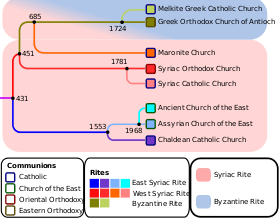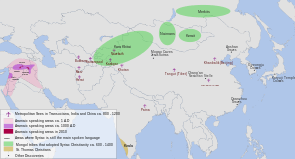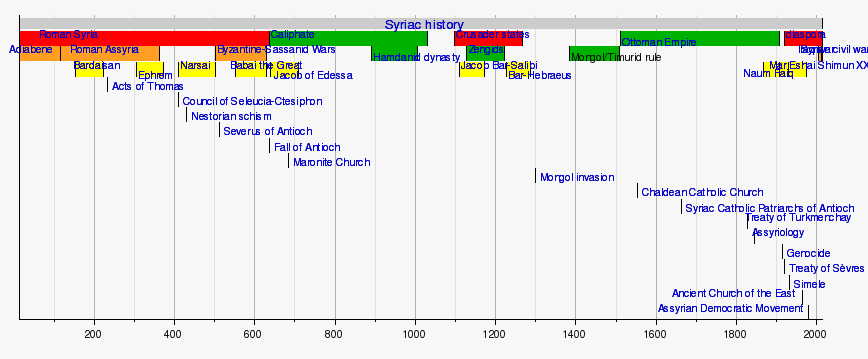Syriac Christianity
| Part of a series on |
| Eastern Christianity |
|---|
 |
|
Liturgy and worship |
|

Syriac Christianity (Syriac: ܡܫܝܚܝܘܬܐ ܣܘܪܝܝܬܐ / mšiḥāiūṯā suryāiṯā) encompasses the multiple Churches of Eastern Christianity whose services tend to feature liturgical use of ancient Syriac, a dialect of Middle Aramaic that emerged in Edessa in the early 1st century AD, and is closely related to the Aramaic of Jesus.[1]
With a history going back to the 1st century AD, Syriac Christianity is, in modern times, represented by denominations primarily in the Middle East, Asia Minor and in Kerala, India.
Christianity began in the Middle East in Jerusalem among Jewish Aramaic-speaking Semitic peoples of Judah (modern Israel, Palestinian Territories and Jordan). It quickly spread, initially to other Semitic peoples, in Parthian-ruled Assyria and Mesopotamia (modern Iraq), Roman-ruled Syria (ancient Aramea), Phoenicia (modern Lebanon), southern and eastern Asia Minor (modern Turkey), and northwestern Persia (modern Iran) and Malta. From there it spread to Greece, Armenia, Egypt, Georgia, the Caucasus region and on into the Balkans, India, North Africa, Rome, Ethiopia, Nubia (modern Sudan) and Arabia, and eventually southern and western Europe.
Syriac Christianity is divided into two major Rite traditions: the East Syrian Rite, historically centered in Assyria/Upper Mesopotamia, and the West Syrian Rite, centered in Antioch and the Mediterranean coast (the Levant).
The East Syrian Rite tradition was historically associated with the Assyrian founded Church of the East, and it is currently employed by the Middle Eastern churches that descend from it: the Assyrian Church of the East, the Ancient Church of the East, and the Chaldean Catholic Church (the members of such churches are Eastern Aramaic-speaking ethnic Assyrians) as well as by the Syro-Malabar Catholic Church of India.
The West Syrian Rite tradition is used by the Syriac Orthodox Church, the Syriac Catholic Church, the Maronite Catholic Church as well as by the Malankara Churches in India, which follows the Saint Thomas Christian tradition. Adherents sometimes identify as Syriacs or Syrians.
History

Syriac Christian heritage is transmitted through various Neo Aramaic dialects (particularly the Syriac dialect of Assyria and Upper Mesopotamia) of old Aramaic. Unlike the Greek Christian culture, Assyrian Christian culture borrowed much from early Rabbinic Judaism and its own indigenous ancient Mesopotamian culture. Whereas Latin and Greek Christian cultures became protected by the Roman and Byzantine empires respectively, Syriac Christianity often found itself marginalised and sometimes actively persecuted by the Zoroastrian rulers of the Parthian Empire and succeeding Sassanid Empire. Antioch was the political capital of this culture, and was the seat of the Patriarchs of the church. However, Antioch was heavily Hellenized, and the Assyrian cities of Edessa, Nisibis and Sassanid Ctesiphon became Syriac cultural centres.
The early literature of Syriac Christianity includes the Diatessaron of Tatian; the Curetonian Gospels and the Syriac lSinaiticus; the Peshitta Bible; the Doctrine of Addai and the writings of Aphrahat; and the hymns of Ephrem the Syrian.
The first division between Syriac Christians and Western Christianity occurred in the 5th century, following the First Council of Ephesus in 431, when the Assyrian Christians of the Sassanid Persian Empire were separated from those in the west over the Nestorian Schism. This split owed just as much to the politics of the day as it did to theological orthodoxy. Ctesiphon, which was at the time also the Sassanid capital, eventually became the capital of the Church of the East.
After the Council of Chalcedon in 451, many Syriac Christians within the Roman Empire rebelled against its decisions. The Patriarchate of Antioch was then divided between a Chalcedonian and non-Chalcedonian communion. The Chalcedonians were often labelled 'Melkites' (Emperor's Party), while their opponents were labelled as Monophysites (those who believe in the one rather than two natures of Christ) and Jacobites (after Jacob Baradaeus). The Maroniote Church found itself caught between the two (allegedly embracing Monothelitism), but claims to have always remained faithful to the Catholic Church and in communion with the bishop of Rome, the Pope.[2]
The church has persisted as a separate entity under Islamic rule. The community was one of those granted autonomy in governing itself in religious and family matters under the millet system.[3] In the 19th century many left for other parts of Christendom, creating a substantial diaspora.[4]
Over time, some groups within each of these branches have entered into communion with the Church of Rome, becoming Eastern Catholic Churches.
Names and ethnicity



The term "Syrian" (and by extension "Syriac") was originally an Indo-European corruption of "Assyrian" (Assurayu), and was used by speakers of Indo-European languages exclusively in relation to Assyria in northern Mesopotamia, from the period of the Neo Assyrian Empire (935-605 BC) onwards.[5] During the Seleucid Empire (323-150 BC), its Greek rulers applied the name not only to Assyria proper and its people, but also to Biblical Aramea in the Levant, which had been a colony of Assyria during the Middle Assyrian Empire (1366-1020 BC) and Neo Assyrian Empire (911-605 BC). When they lost Assyria itself to the Parthian Empire, they retained the name "Syria" but only applied it to what had been Aramea, which they still retained.[6][7] This led to the Greco-Roman and later European tradition of referring to both Assyrians/Mesopotamians and Arameans as "Syrians" and "Syriacs", despite both being historically, ethnically, linguistically, genetically and geographically distinct from one another.[8]
The indigenous Assyrians (Syriac: ܣܘܪܝܝܐ, Arabic: سُريان) of Mesopotamia adopted Christianity very early, and from the 1st century A.D. onwards it began to supplant the three millennia old traditional Mesopotamian religion, although this religion did not fully die out until as late as the 10th century AD. The Neo-Assyrian kingdom of Osroene was the first Christian kingdom in history.
In 431 A.D. the Council of Ephesus declared Nestorianism to be a heresy. The Nestorian priests, who were persecuted in the Byzantine Empire, sought refuge in Mesopotamia where the Church of the East was dominant, then part of the Sassanid Empire. There was a synthesis between the Assyrian Church and Nestorian doctrine. From there they spread Christianity to Persia, India, China, and Mongolia. This was the beginning of the Nestorian Church, the eastern branch of Syrian Christianity. The western branch, the Jacobite Church, appeared after the Council of Chalcedon condemned Monophysitism in 451 A.D.[9]
Members of the Assyrian Church of the East, Ancient Church of the East, the Chaldean Catholic Church, Assyrian Evangelical Church, Assyrian Pentecostal Church church as well as those of the Syriac Orthodox Church and Syriac Catholic Church from northern Iraq, north western Iran, north eastern Syria and south eastern Turkey that corresponds to the indigenous Assyrian homeland areas, which are "part of today's northern Iraq, southeastern Turkey, northwestern Iran and northeastern Syria"[10] are ethnic Assyrians, descendants of the ancient Assyrians (see Assyrian continuity). This ethnic group still speak Akkadian infused Eastern Aramaic dialects and are indigenous to northern Iraq, south eastern Turkey, north eastern Syria and north western Iran, and still retain Akkadian-Assyrian family, tribal and personal names.
Many now largely Arabic speaking Syriac Orthodox and Syriac Catholics from the bulk of Syria (excluding the Assyrian northeast) and south central Turkey prefer a Syriac-Aramean national identity while others adhere to a purely religious Syriac identity.
A small number of mainly United States based Chaldean Catholics have also recently adopted a Chaldean or Chaldo-Assyrian national identity, despite there being absolutely no historical, archaeological, written, linguistic or geographical evidence whatsoever to support any link to the long extinct Chaldeans of the far southeast of Mesopotamia. These people are in fact ethnic Assyrians originating from the Assyrian homeland in northern Iraq.
The older Assyrian designation has almost completely replaced the word Nestorian (which is seen by Assyrians as pejorative and meaningless as an ethnic term). However, the word Nestorian continues to be used in some Western academic literature.
The use of the word Syriac (which originally referred to the Syrian language, a dialect of Middle Aramaic which arose in Assyria) instead of Syrian became common after the establishment of the Arab majority modern nation of Syria after World War I, Assyrians and Syriac-Arameans not being Arabs and wishing to distinguish themselves from them. The word 'Syrian' has become ambiguous in English since it can refer now to a citizen of Syria regardless of ethnicity, and is also now largely accepted to have originally meant Assyrian. In Arabic, however, the word for a 'citizen of Syria' has a different form (سوري sūrī) from the traditional word for an ethnic Assyrian/Syrian (سُرياني suryānī).
The Maronites in Lebanon are divided between those who claim Lebanese-Phoenician national identity (see Phoenicianism) and those who claim Arab national identity (see Arab nationalism).
Churches of the Syriac tradition

- West Syrian Rite
- The Syriac Orthodox Church (Non-Chalcedonian Oriental Orthodox Church of Antioch and all the East)
- The Jacobite Syrian Christian Church; (Non-Chalcedonian Oriental Orthodox Church of India within the Syriac Orthodox Patriarchate)
- The Malankara Orthodox Syrian Church (Autocephalous; Non-Chalcedonian Oriental Orthodox Church of India) with her part the Brahmavar (Goan) Orthodox Church
- The West Syrian Rite Churches under the Catholic Church
- The Syriac Catholic Church, a West Syrian Rite Eastern Catholic church.
- The Maronite Church, a West Syrian Rite Eastern Catholic Church.
- The Syro-Malankara Catholic Church, a West Syrian Rite Eastern Catholic Church based in Kerala, India.
- The Malankara Marthoma Syrian Church. (Mar Thoma Church), an Eastern Oriental church based in Kerala, India. Mar Thoma church is in communion with the Anglican Church.
- The Malabar Independent Syrian Church (Thozhiyur church), an independent church based in Kerala, India.
- The Syriac Orthodox Church (Non-Chalcedonian Oriental Orthodox Church of Antioch and all the East)
- East Syrian Rite
- Church of the East, founded in Assyria, became known as the Nestorian Church, once widely spread through Asia
- The Assyrian Church of the East, the direct continuation of the Church of the East
- The Chaldean Syrian Church an archbishopric the Assyrian Church India based
- The Ancient Church of the East, split from the Assyrian Church of the East in the 1960s
- The East Syrian Rite Churches under the Catholic Church
- The Chaldean Catholic Church (originally called The Church of Assyria and Mosul), an East Syrian Rite Eastern Catholic Church, only emerged from the Church of the East following the split with the Assyrian Church in the 1683 AD.
- The Syro-Malabar Catholic Church, an East Syrian Rite Eastern Catholic Church based in Kerala, India
- The Assyrian Church of the East, the direct continuation of the Church of the East
- Church of the East, founded in Assyria, became known as the Nestorian Church, once widely spread through Asia
Syrian Christians were involved in the mission to India, and many of the ancient churches of India are in communion with their Syriac cousins. These Indian Christians are known as Saint Thomas Christians.
In modern times, various Evangelical denominations began to send representatives among the Syriac peoples. As a result, several Evangelical groups, particularly the "Assyrian Pentecostal Church" (most in America, Iran, and Iraq) have been established and the Aramean Free Church (most in Germany, Sweden, Amerika and Syria). However, despite these Assyrian protestants having been converted from the Assyrian Church of the East and Chaldean Catholic Church, due to their recent historical origin, such groups and others are not normally classified among those Eastern Churches to which the term "Syriac Christianity" is traditionally applied.
See also
- Assyrian Church of the East
- Chaldean Catholic Church
- Ancient Church of the East
- Terms for Syriac Christians
- West Syrian Rite
- East Syrian Rite
- Saint Thomas Christians
- Saint Thomas Christian Churches
Notes
- ↑ Allen C. Myers, ed (1987). "Aramaic". The Eerdmans Bible Dictionary. Grand Rapids, Michigan: William B. Eerdmans. p. 72. ISBN 0-8028-2402-1. "It is generally agreed that Aramaic was the common language of Palestine in the first century A.D. Jesus and his disciples spoke the Galilean dialect, which was distinguished from that of Jerusalem (Matt. 26:73).". Israeli scholars have established that Hebrew was also in popular use. Most Jewish teaching from the first century is recorded in Hebrew.
- ↑ Moosa, Matti. The Maronites in history. Syracuse: Syracuse University Press, 1986
- ↑ Ye'Or, Bat. The decline of eastern Christianity under Islam: from jihad to dhimmitude. Rutherford: Fairleigh Dickinson University Press, US, 1996
- ↑ Chaillot, Christine. "The Syrian Orthodox Church Of Antioch And All The East. Geneva: Inter-Orthodox Dialogue 1998
- ↑ ^ Rollinger, Robert (2006). "The terms "Assyria" and "Syria" again" (PDF). Journal of Near Eastern Studies 65 (4): 284–287. doi:10.1086/511103.
- ↑ ^ Tekoglu, R. & Lemaire, A. (2000). La bilingue royale louvito-phénicienne de Çineköy. Comptes rendus de l’Académie des inscriptions, et belleslettres, année 2000, 960-1006.
- ↑ Inscription From 800 BC Shows the Origin of the Name 'Syria'
- ↑ ^ Yepiskoposian et al., Iran and the Caucasus, Volume 10, Number 2, 2006, pp. 191-208(18), "Genetic Testing of Language Replacement Hypothesis in Southwest Asia"
- ↑ T.V. Philip, East of the Euphrates: Early Christianity in Asia
- ↑ Reforging a Forgotten History: Iraq and the Assyrians in the Twentieth Century By Sargon Donabed
References
- Baum, Wilhelm; Winkler, Dietmar W. (2003). The Church of the East: a concise history. Routledge. ISBN 978-0-415-29770-7.
External links
- Jacobite Syrian Church
- (French) - Translation into English Syriac Christianity on WikiSyr
- (French) - Translation into English Syriac Catholic Circle
- Qambel Maran- Syriac chants from South India- a review and liturgical music tradition of Syriac Christians revisited
- Traditions and rituals among the Syrian Christians of Kerala
- Audio Aramaic-Bible
- A Comprehensive Bibliography On Syriac Christianity
